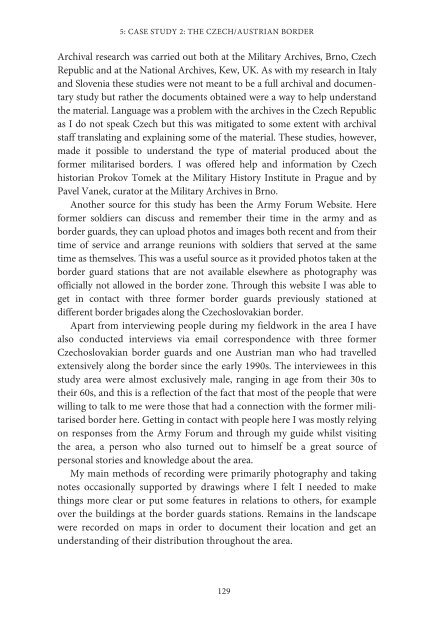1JZGauQ
1JZGauQ
1JZGauQ
Create successful ePaper yourself
Turn your PDF publications into a flip-book with our unique Google optimized e-Paper software.
5: CASE STUDY 2: THE CZECH/AUSTRIAN BORDER<br />
Archival research was carried out both at the Military Archives, Brno, Czech<br />
Republic and at the National Archives, Kew, UK. As with my research in Italy<br />
and Slovenia these studies were not meant to be a full archival and documentary<br />
study but rather the documents obtained were a way to help understand<br />
the material. Language was a problem with the archives in the Czech Republic<br />
as I do not speak Czech but this was mitigated to some extent with archival<br />
staff translating and explaining some of the material. These studies, however,<br />
made it possible to understand the type of material produced about the<br />
former militarised borders. I was offered help and information by Czech<br />
historian Prokov Tomek at the Military History Institute in Prague and by<br />
Pavel Vanek, curator at the Military Archives in Brno.<br />
Another source for this study has been the Army Forum Website. Here<br />
former soldiers can discuss and remember their time in the army and as<br />
border guards, they can upload photos and images both recent and from their<br />
time of service and arrange reunions with soldiers that served at the same<br />
time as themselves. This was a useful source as it provided photos taken at the<br />
border guard stations that are not available elsewhere as photography was<br />
officially not allowed in the border zone. Through this website I was able to<br />
get in contact with three former border guards previously stationed at<br />
different border brigades along the Czechoslovakian border.<br />
Apart from interviewing people during my fieldwork in the area I have<br />
also conducted interviews via email correspondence with three former<br />
Czechoslovakian border guards and one Austrian man who had travelled<br />
extensively along the border since the early 1990s. The interviewees in this<br />
study area were almost exclusively male, ranging in age from their 30s to<br />
their 60s, and this is a reflection of the fact that most of the people that were<br />
willing to talk to me were those that had a connection with the former militarised<br />
border here. Getting in contact with people here I was mostly relying<br />
on responses from the Army Forum and through my guide whilst visiting<br />
the area, a person who also turned out to himself be a great source of<br />
personal stories and knowledge about the area.<br />
My main methods of recording were primarily photography and taking<br />
notes occasionally supported by drawings where I felt I needed to make<br />
things more clear or put some features in relations to others, for example<br />
over the buildings at the border guards stations. Remains in the landscape<br />
were recorded on maps in order to document their location and get an<br />
understanding of their distribution throughout the area.<br />
129




